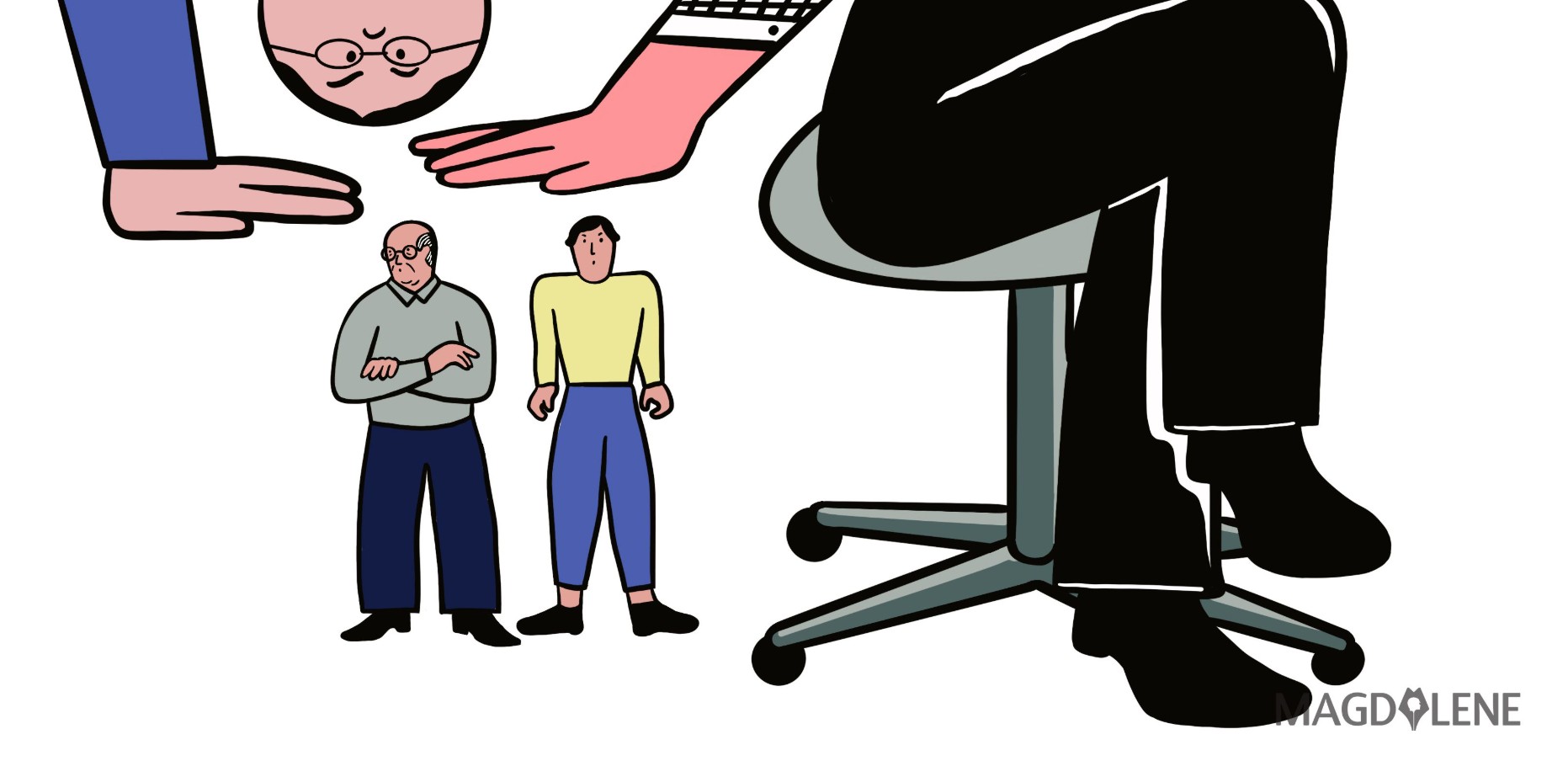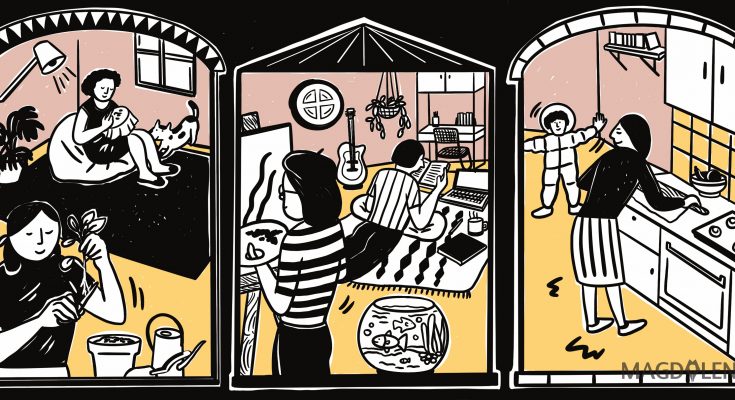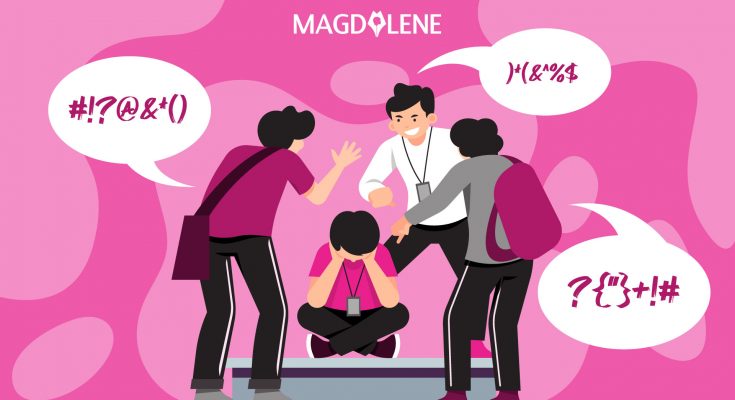
‘Girl Boss’ di Film Indonesia: Stereotipikal atau Tidak?
Sebagai perempuan pekerja, saya mendambakan film karya sineas Indonesia yang menampilkan karakter pemimpin perempuan nan berdaya dan mandiri. Saya pun menelusuri film-film yang diproduksi oleh para sineas Tanah Air dari 2014 hingga 2021. Hasilnya tak banyak. Sebagian di antaranya adalah Kapan Kawin (2015), Susah Sinyal (2017), Milly & Mamet: Ini Bukan Cinta & Rangga (2018), Twivortiare (2019), serta Devil on Top (2021).
Film-film tersebut saya pilih karena menampilkan karakter pemimpin perempuan di dalamnya. Selain menyusuri keberadaan mereka, saya juga menganalisis bagaimana sineas film merepresentasikan karakter bos perempuan. Kemampuan sineas Indonesia dalam merepresentasikan girl boss ini penting dijadikan sebagai tolak ukur bagi saya untuk mengetahui apakah mereka sudah bersedia meruntuhkan berbagai stereotip negatif yang kerap dilekatkan pada para bos perempuan, yang kerap beresonansi dengan pelbagai ketidakadikan gender.
Sterotip negatif mengenai girl boss sendiri memang sedang kencang-kencangnya digaungkan sejak 2014. Tepatnya ketika pebisnis Sophia Amoruso lewat memoir #Girlboss rilis. Alexandra Solomon, profesor dalam bidang gender dan peran gender di Northwestern University, mengatakan kepada Vox, istilah girl boss yang kita kenal sekarang adalah bentuk dari seksisme yang terinternalisasi. Ini menekankan pada stereotip negatif bos perempuan yang menjadi sosok yang dibenci banyak orang. Kendati perempuan, gaya kepemimpinan mereka dicitrakan sangat maskulin yang menekankan pada agresi karena berusaha untuk mendobrak dunia yang didominasi lelaki.
Baca Juga: Mulai dari Makna Pemberdayaan hingga Eksploitasi, Kompleksnya Istilah ‘Girlboss’
Berikut ini adalah temuan saya usai menonton kelima film Indonesia soal girlboss di atas.
Benarkah Film Indonesia Mampu Merepresentasikan Girl Boss?
Saya dan mungkin banyak perempuan di Indonesia sependapat, kami sudah muak sekali dengan stereotip negatif bos perempuan yang dilanggengkan di masyarakat. Stereotip mendasar dari bos perempuan itu tak jauh-jauh dari karakter bossy, secara emosional manipulatif karena suka gaslighting, melakukan abuse of power, dan tentunya bitchy. Stereotip negatif ini sudah begitu melekat pada bos perempuan sampai-sampai di kehidupan nyata sendiri, seseorang bisa langsung mengalami keringat dingin jika mengetahui atasan barunya perempuan.

Stereotip negatif yang seharusnya diruntuhkan sayangnya justru kembali dilanggengkan utamanya dalam film Devil on Top (2021) yang disutradarai Anggy Umbara. Sejak awal film ini dimulai pun penonton sudah disuguhkan dengan adegan di mana semua orang di kantor takut dengan sosok bos perempuan mereka bernama Sarah. Ketika Sarah masuk kantor, suasana kantor menjadi tegang. Mereka semua heboh menyusun bangku, duduk rapi di meja kerja masing-masing agar tidak kena omel sang bos.
Angga, karakter laki-laki utama yang ketika itu telat datang rapat bersama Sarah pun kena damprat. Di dalam adegan yang sama, Sarah bahkan marah-marah kepada Boni, salah satu karyawan yang menyiapkan kopi Sarah. Sarah marah karena Boni menyiapkan kopi kepada Sarah dengan takaran gula sebanyak dua setengah sendok, padahal Sarah biasanya hanya minum kopi dengan gula setengah sendok saja.
Adegan di mana Sarah adalah bos yang sangat menyebalkan pun berulang kali ditampilkan di layar. Ia digambarkan sebagai bos perempuan yang suka marah-marah, gaslighting, dan tentunya hobi menekan karyawannya. Ia bahkan tidak segan memecat karyawannya dengan cara disidang di depan karyawan-karyawan lain tanpa memberikan kesempatan karyawan tersebut untuk mengubah perilakunya yang baru saja ia lakukan satu kali. Ia juga kerap menyuruh karyawannya yang jelas merupakan manifestasi dari power abuse. Sifat Sarah ini membuat karyawan-karyawannya sangat stress dan membencinya sampai titik di mana Angga dan ketiga teman satu gengnya berencana untuk menjatuhkan Sarah dari posisinya tersebut.

Kendati Sarah adalah bos yang menyebalkan di kantor, dalam film ini latar belakangnya makin lama terkuak. Ia dipaksa bekerja di sini oleh Pak Firman–sosok yang juga melakukan pelecehan seksual terhadapnya. Sarah bertahan karena ia masih harus menghidupi anaknya yang mempunyai sindrom Williams. Namun, dari penceritaan latar belakang ini, saya justru jadi bertanya-tanya tentang intensi penulis naskah, Anggy Umbara dan Rayhan Dharmawan.
Baca Juga: Bos perempuan dalam Film: Kurang Representasi, Diseksualisasi
Penulis naskah tidak hanya melanggengkan stereotipe negatif bos perempuan, tetapi mereka seakan-akan menjustifikasi perilaku toksik Sarah sebagai seorang atasan dengan menyetir penonton untuk bersimpati dan memaafkan perilakunya. Hal ini jelas berbahaya, karena mau bagaimana pun latar belakang kehidupan seseorang tidak bisa menjadi alat justifikasi seseorang untuk bersikap tidak adil dan toksik terhadap orang lain.
Harapan dan Lubang Besar
Setelah menonton Devil on Top, timbul sebuah kekhawatiran mendalam mengenai representasi perempuan di budaya populer. Saya khawatir film-film yang mengangkat karakter perempuan girlboss ini justru berperan dalam melanggengkan ketidakadilan gender melalui stereotip negatif. Namun, untungnya setelah saya menonton empat film Indonesia lain, saya menemukan ada upaya dari para sineas Indonesia untuk menggambarkan karakter perempuan girl boss yang berdaya dan mandiri dengan representasi lebih baik yang perlahan mampu meruntuhkan stereotip negatif sebelumnya.
Girl boss ditampilkan sebagai karakter perempuan berdaya yang bertanggung jawab, tegas dengan gaya kepemimpinan perempuan, seperti kolaboratif, komunikatif, fleksibel, sabar, dan empatik. Tidak jarang beberapa perempuan dalam keempat film ini digambarkan dekat dengan kolega dan karyawan-karyawan yang ia pimpin. Dalam film Kapan Kawin (2015) yang disutradarai oleh Ody C, misalnya Dinda, General Manager di sebuah hotel bintang empat adalah seorang yang tidak pernah melakukan abuse of power, bossy, dan bitchy. Meski jadi atasan, ia sigap dan sebisa mungkin membantu pekerjaan karyawannya, yang sebenarnya bukan bagian dari job desk miliknya (dari memindahkan meja klien sampe nolongin orang tenggelam). Ia tidak pernah melimpahkan tanggung jawab kepada karyawannya secara semena-mena.
Baca Juga: ‘Athena Doctrine’ dan Mengapa Nilai-nilai Feminin Penting dalam Memimpin
Begitu pula dengan karakter Ellen di Susah Sinyal (2017). Ia adalah seorang ibu tunggal dan pengacara yang membuat firma hukumnya sendiri bersama koleganya, Iwan. Selama bekerja ia menekankan pada kolaborasi bersama tim kecilnya. Ia juga tidak pernah melakukan abuse of power, hal ini bisa dilihat dari bagaimana ia bahkan tidak enak hati pada teman satu timnya jika ia tidak bisa menghadiri pengadilan atau mengambil cuti liburan bersama dengan putrinya, Kiara.
Sosok bos perempuan yang egaliter juga terlihat dalam sosok Milly di Milli & Mamet: Ini Bukan Cinta & Rangga (2018). Sebagai seseorang yang menggantikan posisi suaminya sebagai kepala pabrik yang dimiliki ayahnya, Milly bisa dibilang bos perempuan yang jauh dari stereotip negatif. Layaknya Ellen, kepemimpinannya dilakukan atas dasar kerjasama tanpa ada relasi timpang. Ia sangat dekat dengan karyawan-karyawannya bahkan dalam beberapa adegan dia sering bergurau dengan karyawannya seperti bersama dengan Yongki yang nantinya akan menjadi pengganti Milly. Sedangkan Alexa dalam Twivortiare (2018) walaupun tidak begitu banyak dibahas mengenai gaya kepemimpinannya, ia adalah seorang Vice President yang dapat diandalkan. Ia juga dekat dengan koleganya, Ryan berbeda dengan karakter Sarah yang benar-benar menjadi karakter antagonis di mana tidak ada seorang pun yang dekat dengan dirinya.

Representasi cukup positif dari bos perempuan dalam keempat film ini tentu menjadi angin segar bagi perempuan, termasuk saya yang sudah lama mendambakan representasi perempuan di budaya populer. Namun, sayangnya, film-film ini masih belum memiliki fokus khusus terhadap cerita bos perempuan dalam pergulatannya dalam dunia kerja. Keempat film ini masih terfokus pada cerita romansa dengan sentuhan humor dan drama. Porsi adegan yang memperlihatkan bagaimana perempuan bekerja dan memperlihatkan gaya kepemimpinannya masih bisa dibilang cukup minim.
Hal ini tidak lain karena karakter bos perempuan hanya dijadikan sebagai plot pelengkap saja atau pemanis yang memperlihatkan “Oh ternyata ada juga lho bos perempuan yang tidak bossy dan bitchy”. Untuk hal itu, sineas Indonesia pada kenyataannya masih memiliki PR besar untuk dapat memproduksi film dengan fokus cerita mengenai bos perempuan dengan segala gaya kepemimpinan dan kendalanya sebagai perempuan dalam menjalankan suatu perusahaan.
Read More
























